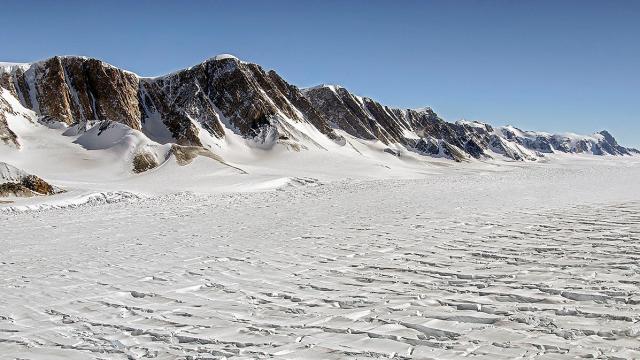When scientists talk about Antarctic melting, they’re usually referring to West Antarctica, where giant coastal glaciers are shedding incredible amounts of water. But across the Transantarctic mountains to the east, there’s a much larger mantle of ice that’s generally thought to be keeping its chill. A new study, however, asserts that East Antarctica is also losing weight at a worrying clip.
Research published today in the Proceedings of the National Academies of Sciences points to a steady decline in the amount of ice covering East Antarctica since satellite record-keeping began in 1979. While the study finds mass loss from East Antarctica is still lagging behind its neighbour to the West—the former has recently lost some 50 billion tons of ice per year to the latter’s 160 billion — East Antarctica is still a “major contributor” to Antarctica’s slim-down.
All told, the study estimates East Antarctica has added 4.4 millimetres to Earth’s global sea level since 1979, compared with 6.9 millimetres from the West. Worryingly, East Antarctica holds 52 of the 57 potential feet of sea level rise locked away in Antarctic ice.
Close observers of what’s happening to the frozen continent will know that these are somewhat radical glaciological conclusions. In fact, a might even be gaining mass due to increased snowfall.
While the Nature paper synthesized a number of different techniques and datasets from satellite-derived gravity measurements to altimetry, the new study zeroed in on a single method: the so-called component method. Essentially, the researchers subtracted data on how much ice flows into the ocean each year from data on how much snow falls on the continent.
By extending this method further back in time and integrating all the latest datasets, the authors were able to tease out a downward trend for East Antarctica, particularly within the Wilkes Land sector, which they found has been losing mass for 40 years.
Otherwise, the numbers agree quite well between the new study and the 2018 paper, University of Leeds cryosphere scientist Andrew Shepherd, who led the recent analysis in Nature, told Earther.
“What’s different is the mass budget team [the new study’s authors] have changed the way they estimate errors, which makes their results appear to be about five times more precise,” Shepherd wrote Earther in an email, adding that the new results for East Antarctica represent something of an “outlier.”
That suggests it’s far from the end of the story for this very big, very remote, and very poorly studied part of the world. New datasets expected to come online from satellite missions like GRACE-Follow On, which uses gravity data to track Antarctica’s weight loss, and ICESat-2, which measures the height of icy surfaces, should help researchers refine the picture even further.
But this isn’t the first time a study has punched a hole in East Antarctica’s icy fortitude. A study published last summer found that two critical East Antarctic outlet glaciers, Totten and Moscow University glacier, are shedding some 18 billion tons of ice a year. More recently, NASA researchers estimated that four glaciers west of Totten have lost nine feet of surface height since 2008.
One thing’s for certain: If East Antarctica is losing weight, and if that trend accelerates, the future of Earth’s coastlines could start to look a lot dimmer.
